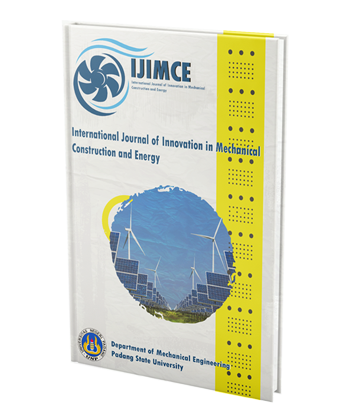Performance of Percentage Refusal Density (PRD) in Asphalt Concrete – Wearing Course (AC-WC) Mixtures with Silica Sand Substitution as Fine Aggregate
DOI:
https://doi.org/10.24036/ijimce.v1i3.46Keywords:
Asphalt, AC-WC, Silica Sand, KAO, RefusalAbstract
Indonesia is experiencing significant traffic load growth; however, this is often not matched by the development of adequate road infrastructure. This phenomenon occurs because traffic load growth is faster than the development of road infrastructure. Excessive traffic load can cause damage to the roads. Aggregates, especially fine aggregates, play an important role in flexible pavement layers, particularly in the AC-WC layer. The AC-WC layer aims to provide smoothness, safety, and comfort for road users while protecting the underlying layers from damage caused by traffic loads, such as subsidence, ruts, and asphalt deformation. The use of silica sand has become one alternative to improve the quality of the AC-WC layer. This study aims to obtain the Optimal Asphalt Content (KAO) value and the Refusal Optimal Asphalt Content (KAO) value. The KAO value using the Marshall method in the AC-WC mixture is 5.99% for 0% silica sand variation, 5.88% for 25% silica sand variation, 5.845% for 50% silica sand variation, 5.835% for 75% silica sand variation, and 5.810% for 100% silica sand variation. The Refusal KAO value is 5.920% for 0% silica sand variation, 5.83% for 25% silica sand variation, 5.785% for 50% silica sand variation, 5.750% for 75% silica sand variation, and 5.775% for 100% silica sand variation. Thus, the greater the percentage of silica sand added as a substitute for fine aggregates in the AC-WC mixture, the lower the Marshall KAO and Refusal KAO values obtained.
Downloads
References
Asmuni (2010). "Characteristics of Quartz Sand (SiO2) Using XRD Method." Faculty of Mathematics and Natural Sciences, University of Sumatera, Medan.
Directorate General of Highways (2018). "2018 General Specifications for Road and Bridge Works." South Jakarta.
Arifin, M., dan Suhala, S,(1997)”. Bahan Galian Industri, Pusat Penelitian dan Pengembangan Teknologi Mineral (PPTM)”, Bandung
Directorate General of Highways (1999). "Technical Guidelines for Asphalt Mix Design Using Maximum Density ApprKAOh." Jakarta: PT. Medisa (PT. Mediatama Saptakarya).
Diwanta and Bestari (2015). "Purification of Silica Sand Using Sonication Process in Oxalic Acid Medium." Surabaya.
Ibrahim et al. (2021). "Analysis of Poisson Ratio and Deformation Resistance of AC-WC Mixture with Silica Sand Substitution," pp. 36–47.
Junaedi Dena Ramadhan (2020). "Effect of Quartz Sand Use as Fine Aggregate Replacement Material for AC-BC Pavement," 2, pp. 109–117.
Mataram I Nyoman Karnata et al. (2020). "Characteristics of HRS-WC Mixture Using Quartz Sand as Fine Aggregate," 24, pp. 150–160.
Permana M. Iqbal Herdiansyah et al. (2019). "Utilization of Quartz Sand and Fly Ash in AC-BC Mixture," 9, pp. 969–978.
Ramadhan Gayuh Bintang and Suparma Latif Budi (2018). "Effect of Quartz Sand Use on AC-WC Asphalt Concrete as Fine Aggregate Replacement," 4, pp. 91–104.[10] Ramadhan Moh Zulfi and Iduwin Tommy (2022). "Effect of PRD and Marshall Characteristics on Rubber Tire Powder in HRS-WC Mixture," 4, pp. 1–8.
Sukirman (2010). "Design of Flexible Pavement Structure Thickness." Bandung.
Sukirman (2016). "Hot Mix Asphalt Concrete." Bandung.
he Asphalt Institute (1983). "Mix Design Methods for Asphalt Concrete and Other Hot-Mix Types," Manual Series No. 2, Sixth Edition, The Asphalt Institute, pp. 1–78, 109–112.
Wirahaji Ida Bagus (2012). "Analysis of Optimum Asphalt Content of Laston Wearing Course on Simpang Sakah–Simpang Blahbatuh Road," 2, pp. 117–131.
Leni, D., Utami, L. P., Sumiati, R., Camim, M., & Khan, S. (2024). Predictive Modeling For Low Alloy Steel Mechanical Properties: A Comparison Of Machine Learning Algorithms And Parameter Optimization. IJIMCE: International Journal of Innovation in Mechanical Construction and Energy, 1(1), 11-20.
Yusuf et al. (2015). "Study of Optimum Asphalt Content Using Marshall and Percentage Refusal Density Equipment," Itenas Journal, 2(1), pp. 1–10.
Downloads
Published
How to Cite
Issue
Section
License
Copyright (c) 2024 Mukhlis mukhlis, Lusyana, Enita Suardi, Denisa Rahma Sukri, Alyza Sazama

This work is licensed under a Creative Commons Attribution-ShareAlike 4.0 International License.




